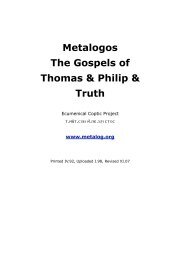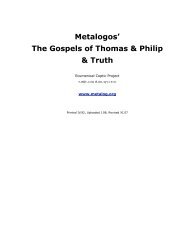Andrew Louth - Syriac Christian Church
Andrew Louth - Syriac Christian Church
Andrew Louth - Syriac Christian Church
Create successful ePaper yourself
Turn your PDF publications into a flip-book with our unique Google optimized e-Paper software.
68 INTRODUCTION<br />
clear and limpid to [the disciples], and were grasped by the mind<br />
without any riddling puzzle or symbolic shadow, revealing the<br />
meaning that lay hidden within them’ (1128B). Or the radiant<br />
garments can be understood as a symbol of ‘creation itself…which can<br />
be understood, through the wise variety of the various forms that it<br />
contains, on the analogy of a garment, to be the worthy power of the<br />
generative Word who wears it’ (1128BC). But in both cases—whether<br />
through the interpretation of Scripture, or through discerning the<br />
logoi of the created order—what one encounters, or rather the one<br />
whom one encounters, is the Transfigured, and therefore Incarnate,<br />
Word of God. There is not then, as Origen sometimes seems to<br />
suggest, a movement away from the Incarnation to some higher<br />
eternal reality (‘Wisdom hidden in a mystery’ in contrast to the Word<br />
‘made flesh’, as Origen once put it), 14 but rather an ever deepening<br />
engagement with the Incarnate Word. Maximus puts this concisely<br />
later on when he says:<br />
The knowledge of all that has come to be through [the Lord] is<br />
naturally and properly made known together with Him. For just<br />
as with the rising of the sensible sun all bodies are made known,<br />
so it is with God, the intelligible sun of righteousness, rising in<br />
the mind: although He is known to be separate from the created<br />
order, he wishes the true logoi of everything, whether intelligible<br />
or sensible, to be made known together with Himself. And this is<br />
shown on the mount of the Transfiguration of the Lord when<br />
both the brightness of his garments and the light of His face<br />
made Him known, and drew to God the knowledge of those who<br />
were after Him and around Him.<br />
(Amb. 10. 27:1156AB)<br />
The sections that follow the meditation on the Transfiguration (section<br />
17) consist of a long series of considerations of the way in which, in<br />
the Incarnate One, all the forms of God’s revelation are summed up<br />
and become comprehensible. Section 18 discusses the<br />
complementarity of the written law (of the Scriptures) and the<br />
natural law (discerned in the order of the cosmos). The natural law is<br />
like a book, and the written law like another cosmos. The next section<br />
once again engages directly with the Origenist monks. Evagrius had<br />
spoken of five principal modes of contemplation: of the adorable and<br />
holy Trinity, of incorporeal beings, of corporeal beings, of judgment<br />
and of providence: 15 from realizing one’s place in God’s providential<br />
order (judgment and providence), one rose from contemplation of<br />
bodies to the incorporeal and thence to contemplation of God.<br />
Maximus speaks instead of five modes of natural contemplation: the




